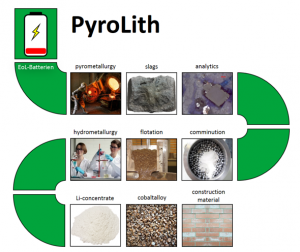PyroLith – Development of a stable process based on the process chains pyrometallurgy-slags processing-hydrometallurgy for the recovery of Li from Mn-containing slags
One option for recycling lithium-ion batteries is pyrometallurgical processing of whole cells or fine fractions after breaking up the cells and separating battery casing parts. One advantage of this process is its high level of robustness and the opportunity to process varying cell generations together or in fluctuating mixtures. The approach chosen in the project is to be extended not only for the current 6-2-2 NMC cell generations but with a view to future cell generations. Co, Ni, Cu, and proportions of Fe and Mn can be converted into the metal melt under suitable furnace operating conditions. The C-carriers are used or burned as reducing agents for the mixed oxides contained in the cells, F is expelled into the dust and exhaust gas flow. Li and Al can be converted quantitatively into a Ca- and Si-containing slag. Specific proportions of Mn and Fe also get into the slag. Whereas in a pure Si-Al-Ca-Li-O system, LiAlO2 crystals can be selectively grown in a silicate matrix, the entire system shifts in the presence of Mn. Depending on the element composition, redox potential and temperature profile in the melt and the cooling phase, different synthetic mineral phases are formed, which also differ in terms of their grain stability.
These valuable carriers are to be separated by appropriate processing, and a residual slag suitable for building material applications is to be produced. The valuable material, in this case initially Li, is to be separated from the pre-concentrates using hydrometallurgical methods and purified to such an extent that a suitable battery raw material can be produced from it again. During the overall process development, an ecological and economic evaluation is to be carried out, which, in comparison with other process routes, will provide decision-making and control aids in order to clarify under which conditions and in which forms the approach developed here is effective.
Seven coordinated objectives will be pursued in various interlocking work packages. Firstly, these deal with the development of a stable process based on the pyrometallurgy-slag processing-hydrometallurgy process chain for the recovery of Li, other potential slag-affine value carriers and a usable residual slag. Secondly, the robustness of the process with different and fluctuating input mixtures, in which at least Co, Ni, Cu and Li can be recovered in battery grade, will be verified. Thirdly, the influence of certain constituents such as Mn or the Mn / Al ratio on the phase formation process and the grain stabilities will be determined. Fourthly, suitable comminution processes and possible pre-sorting by separation and crushing processes depending on the slag structure will be developed. Fifthly, a suitable flotation regime will be developed based on the phase structure and verified for process flexibility in order to separate the lithium carriers from the slag. Sixthly, the leaching behavior of Li carrier phases will be verified depending on the accompanying elements (e.g. Mn). The seventh objective is to derive indicators for the economic and ecological evaluation of the proposed process route depending on the input composition (cell types/cell chemistry), the robustness of the processes against input fluctuations, and comparisons with other routes.
Contact
Clausthal University of Technology – Institute of Mineral and Waste Processing, Waste Disposal and Geomechanics
Prof. Dr.-Ing. Daniel Goldmann
Hao Qiu
Walther-Nernst-Straße 9, 38678 Clausthal-Zellerfeld
ifad.tu-clausthal.de/lehrstuhl-fuer-rohstoffaufbereitung-und-recycling
Duration of project
01.12.2020 – 30.11.2023
Involved partners
